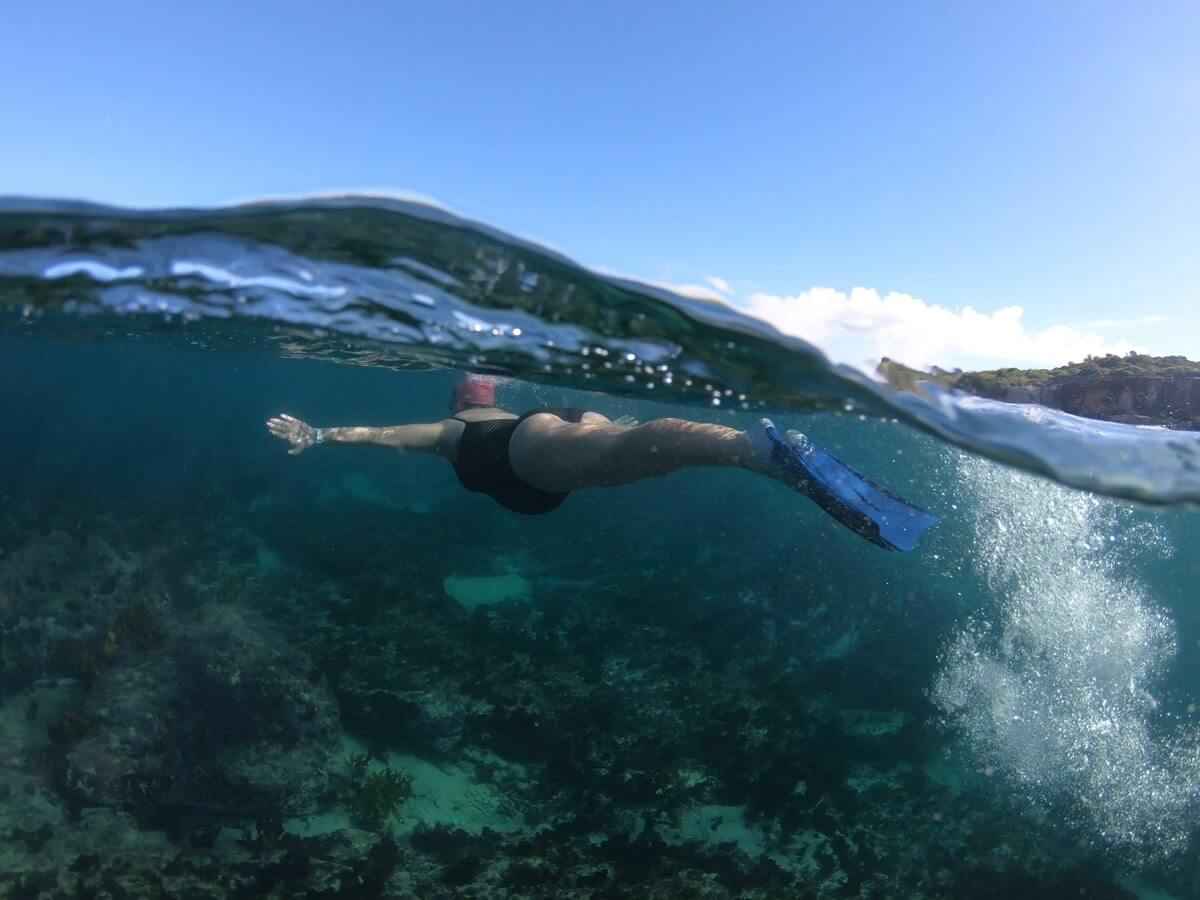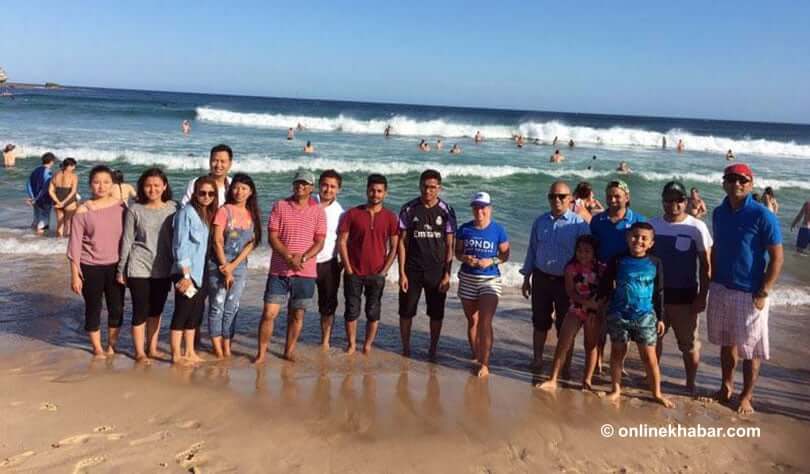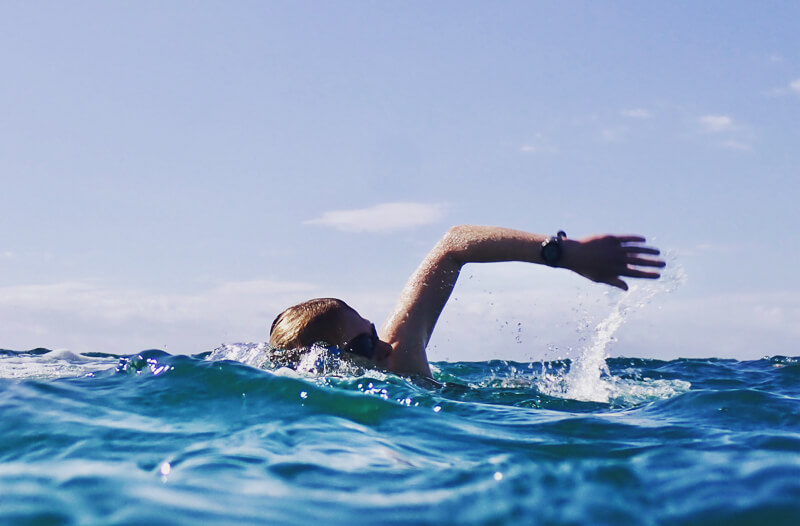Everything you need to know about swimming in cold water

When it comes to swimming in cold water, ocean swimmers tend to fit into three camps:
- those who love and can handle the cold water – the ‘hardiest’,
- those who don’t necessarily like the cold water, but deal with it anyway – the ‘hardy’, and
- those who avoid cold water like the plague – the ‘fair weather swimmers’.
Whether you can handle the cold water, or choose to handle the cold water, will be a mix of physical and mental toughness. It’s also a very personal thing, with what some people think is cold, others will think is warm.
On the physical side, some people can just deal with the temperature better than others. It might be additional body fat layers or genetics that give you an advantage over others.
On the mental side, some people are just mentally tougher and more prepared to deal with the cold. They’re also likely to not want to let the cold get in the way of a swim, and the FOMO (fear of missing out) is too strong.
So what exactly is deemed to be cold water?
Again, that will depend on your cold water threshold and experience, with some people training their bodies to acclimatise to the cold.
At any FINA-sanctioned open water event, their wetsuit policy helps to determine when they believe water starts to become cold for general swimming. Under the FINA wetsuit/cold water policy, you’re required to wear a wetsuit if the temperature drops to between 16 and 18 degrees, and the event is cancelled in water temperature under 16 degrees.
By the time the water is getting to 15 degrees, you will notice the cold chill from the moment you touch the water. This is the temperature at which the average swimmer will start to refer to ‘ice-cream headaches’ – when the brain feels like it’s freezing over.
For most ocean swimmers, it’s where they live that will determine whether they have to deal with swimming in the cold water to get their fix. Although, even in warmer water climates the water temperature will drop through the winter and can even drop five degrees in a day during the summer!

What does it feel like as the water temperature drops?
Coldwater swimming temperature guide from myweather2
Equal to or Above 26°C
Considered very warm and would be enjoyed by all. With this temperature, you can stay active in the water for extended periods of time without feeling uncomfortable.
Below 26°C
Considered warm and would be enjoyed by all, even those who would normally suggest the water was ‘to cold’ for a swim.
Below 22°C
Considered fairly warm and should be enjoyed by most, though some people may still find it a little too cool for their liking.
Below 19°C
Considered relatively cool and though enjoyed by the hardier among us, any more than 10-20 minutes in the sea would leave you feeling refreshed, to say the least.
Below 16°C
Considered cool and for most would feel bracing, to say the least. The hardier among us may enjoy a quick dip.
Below 13°C
Considered cold and even the hardiest among us would find any more than a few minutes in the water uncomfortable.
Below 8°C
Considered very cold and even the hardiest among us would be foolhardy to venture in for a swim and risk hypothermia if exposed for any more than a few minutes.
Below 0°C
Considered extremely cold. It’s possible you would need to clear surface ice to gain access to the water and unless suitably protected with insulated waterproof clothing hypothermia would very quickly occur.
Coldwater swimming safety
Whether or not you believe you’re conditioned for the cold water, or not, the simple fact is that our bodies really aren’t designed for swimming in cold water. Whilst some will learn to acclimatise to the cold water over time, even the hardiest can, and do, succumb to the cold.
The UK’s Outdoor Swimming Society, whose members tend to do a lot of cold water swimming, describe very well four common cold water scenarios that can impact cold water swimmers and how to prevent them.
1. Cold Water Shock
Cold water shock occurs from sudden immersion in water that’s significantly colder than you’re used to or prepared for. The shock is the body’s initial and automatic response to rapid change in skin temperature. It causes, among other things, a sharp intake of breath, an increase in breathing rate and an increase in blood pressure. It typically lasts up to a couple of minutes. For the unwary, cold water shock can be deadly, especially if that sharp intake of breath occurs under water. In addition, if you have an underlying heart condition or hypertension then the sudden change in blood pressure may cause complications.
Enter the water slowly and keep your face clear until your breathing is under control. The cold water response decreases with swimming experience and being mentally prepared.
2. Swim Failure
To protect vital organs in the core, the body restricts blood flow to the limbs when in cold water. If this reaches extreme levels the arms and legs no longer function properly and you can’t swim, resulting in swim failure.
If you feel yourself slowing down or struggling to swim, get out.
3. Hypothermia
Hypothermia occurs when you suffer a drop in core body temperature and it can eventually lead to loss of consciousness and heart failure. The amount of time you can swim in cold water without suffering from hypothermia is determined by the temperature, your body size and shape and your experience, among other factors.
Start with short swims to learn what your limits are. Always swim with other people. If your stroke rate slows down or you start to shiver, get out and warm up.
4. After Drop
When you finish swimming, you also need to concern yourself with something called ‘after drop’. This happens when you exit the water and cool blood from extremities starts circulating through your body again, lowering your core temperature, which is why you often start to shiver a few minutes after you finish swimming.
To minimise the risk, dress immediately starting with the top half of your body. Put on a hat and gloves and have a warm (non-alcoholic) drink.

How to minimise the effects of cold water swimming
The first and most obvious way to minimise the effects of cold water is to wear a wetsuit. However, wetsuits will not prevent cold water shock nor stop you from suffering hypothermia. What they will do is help you to stay warmer for much longer, keep you afloat (in the warmer layer of the water) and, in most cases, allow you to swim faster (potentially spending less time in the water, in the case of a measured distance event).
Learning to acclimatise to the cold water takes time, and is something that long-distance swimmers, like those swimming the channel, plan for as part of their training. Coldwater training camps are run during the colder winter months in the southern parts of Australia and New Zealand.
We put the call out to the Ocean Swimming Enthusiasts Facebook community for help with strategies for dealing with swimming in cold water. These tips are for those who think 15-18 degrees is cold, not for those taking on true cold water swims (you should seek support and advice from experienced cold water swimmers).
Tips for swimming in cold water
- Wear two silicone swim caps. One to keep the heat in, and one to keep the cold out
- Don’t stand around getting cold beforehand
- Wear a neoprene wetsuit, and think about booties and gloves to keep the feet and hands covered too
- There are also neoprene swim caps for your head
- Fatten up over winter so you’ve got a natural layer of body fat
- Practise the Wim Hoff method
- Jog on the sand for 5 minutes before swimming to build up some core body heat
- Wear earplugs
- Read books by ocean swimmers to get tips from those who have spent a lot of time swimming in the cold. Lyn Cox once swam the Bering Strait in 3-degree water in just a swimsuit, cap, and goggles! Read: Swimming to Antarctica: Tales of a Long-Distance Swimmer
Thanks to all the ocean swimmers who contributed via the Ocean Swimming Enthusiasts Facebook Group.
Event organisers, do you have a cold water policy?
If you’re an event organiser, you might want to ensure you have a well-publicised cold water policy so that you know how you’re going to manage this part of your event as the mercury drops, and potential participants know well in advance what the policy is.
In Australia, there isn’t an official body that represents or regulates ocean swimming. However, ocean swim event organisers can take the lead from national sporting organisations (NSO’s) like Triathlon Australia and Swimming Australia, both who run open water swimming events and have comprehensive policies relating to water temperature and wetsuits.
You might like to run your event under one of their policies, or copy the policy and adapt it to your own event.
Here are the parts of the policies for each NSO that relate to water temperature and wetsuits. View the full policy document for the complete policy details (as at 20 Nov 2018).
Triathlon Australia
Race Competition Rules
1. Swimming Conduct
2.1 When wetsuits are allowed, all of the components of the wetsuit will fit to the athletes’ body tightly.
- A competitor may use any swimming stroke for propulsion through the water. It is permissible to tread water or
- A competitor may stand on the bottom or rest by holding an object such as a buoy or stationary boat. However, a competitor may not make use of the bottom or an object to make forward
- In an emergency, a competitor should raise an arm overhead and call for Once assistance is rendered beyond the provision of an object on which to rest, the competitor must withdraw from the event.
- The temperature limits for the use of wetsuits and maximum time to be in the water for the varying swim distances are as follows:
- Elite, Under-23, Open and Junior competitors
| Swim Distance | Forbidden Above | Mandatory Below | Maximum Time |
| Up to 1500m | 20o C | 14o C | 30 minutes |
| 1501m – 3000m | 22o C | 16o C | 1 hour 40 minutes |
| 3001m and above | 22o C | 16o C | 2 hours 15 minutes |
- Under-19 and Age Group competitors
| Swim Distance | Forbidden Above | Mandatory Below | Maximum Time |
| Up to 1500m | 22o C | 14o C | 1 hour 10 minutes |
| 1501m – 3000m | 24.5o C | 15o C | 1 hour 40 minutes |
| 3001m and above | 24.5o C | 16o C | 2 hours 15 minutes |
An interim water temperature reading should be taken 24 hours before race start, and a final water temperature reading should be taken 1 hour before race start. Then a wetsuit ruling advised. If the variation in water temperature is known to be negligible, and the measured temperature is not on the cusp of the wetsuit determination temperatures, then it is acceptable to reduce the number of measurements to one.
Modifications
The Technical Delegate, following consultation with the Medical Director or Event Organiser, may amend the wetsuit determination temperatures for competitor safety reasons. The swim distance can be shortened or even cancelled using the following table as a guide:
| Original swim distance (m) | Adjusted Water Temperature (0C) | ||||||
| Above 32.0 | 31.9 to 31.0 | 30.9 to 16.0 | 15.9 to 15.0 | 14.9 to 14.0 | 13.9 to 13.0 | Below 13.0 | |
| 750 | Cancel | 750m | 750m | 750m | 750m | 750m | Cancel |
| 1500 | Cancel | 750m | 1500m | 1500m | 1500m | 750m | Cancel |
| 3000 | Cancel | 750m | 3000m | 3000m | 1500m | 750m | Cancel |
| 4000 | Cancel | 750m | 4000m | 3000m | 1500m | 750m | Cancel |
Note that the temperatures above are not always the water temperature used in the final decision. If the water temperature is lower than 220C and the air temperature is lower than 150C, then the adjusted value is to decrease the measured water temperature according to the next chart:
| Air Temperature (0C) | |||||||||
| 15 | 14 | 13 | 12 | 11 | 10 | 9 | 8 | ||
| Measured Water Temperature (0C) | 22 | 21.0 | 20.5 | 20.0 | 19.5 | 19.0 | 18.5 | 18.0 | 17.5 |
| 21 | 20.5 | 20.0 | 19.5 | 19.0 | 18.5 | 18.0 | 17.5 | 17.0 | |
| 20 | 17.5 | 17.0 | 16.5 | 16.0 | 15.5 | 15.0 | 14.5 | 14.0 | |
| 19 | 17.0 | 16.5 | 16.0 | 15.5 | 15.0 | 14.5 | 14.0 | 13.5 | |
| 18 | 16.5 | 16.0 | 15.5 | 15.0 | 14.5 | 14.0 | 13.5 | 13.0 | |
| 17 | 16.0 | 15.5 | 15.0 | 14.5 | 14.0 | 13.5 | 13.0 | Cancel | |
| 16 | 15.5 | 15.0 | 14.5 | 14.0 | 13.5 | 13.0 | Cancel | Cancel | |
| 15 | 15.0 | 14.5 | 14.0 | 13.5 | 13.0 | Cancel | Cancel | Cancel | |
| 14 | 14.5 | 14.0 | 13.5 | 13.0 | Cancel | Cancel | Cancel | Cancel |
- A competitor must wear the swim cap if provided by the Race Director on the outside of all other swim caps. For aquathlons or other multi-swim events the wearing of the swim cap if provided is compulsory for the first swim leg and optional in subsequent swim
Swimming Australia
Open Water Swimming Rules
OWS2.5 The water temperature should be a minimum of 16°C and a maximum of 31°C. It should be checked the day of the race, 2 hours before the start in the middle of the course at a depth of 40cm. This control should be done in the presence of a Commission made up of the following persons present: a Referee, a Member of the Organising Committee and one Coach from the Teams present designated during the Technical Meeting.
Australian Open Water Swimming Championship By Laws
OWBL 7 As per FINA regulations, for open water swimming competitions in water with temperature below 20°C (68°F), men and women may use either swimsuits or wetsuits. When the water temperature is below 18°C (64.4°F), the use of wetsuits is compulsory. The water temperature should be a minimum of 16°C and a maximum of 31°C in order to commence the competition.
Wetsuits are swimsuits made of material providing thermal insulation. Wetsuits for both men and women shall completely cover the torso, back, shoulders and knees and shall not extend beyond the neck, wrists or ankles. The thickness of material/s used shall be a minimum 3mm and maximum 5mm. In addition, the outer surface of the wetsuit shall not include outstanding shapes, such as ridges or fins. Outside of the above-mentioned temperature stipulations, swimwear, for both Men and Women, shall not cover the neck, extend past the shoulder, nor shall extend below the ankle. All Open Water swimsuits shall comply with the FINA Criteria for Materials and Approval Procedures.
OceanFit’s cold water swimming resources
- Science-backed benefits of cold water swimming
- How to acclimatise to cold water
- Top tips to prepare for a cold ocean swim
- Managing cold water swimming injuries
- Coriolis Effect: When the water gets cold in summer
- What to look for in an open water swimming wetsuit
- How to choose a wetsuit for ocean-swimming
- Seal your ears for pain-free open water swimming





Responses